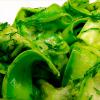Pomelo vitamins and minerals. Useful properties of pomelo: video
Pomelo is the fruit of an evergreen citrus tree. The peel of the pomelo is quite dense, the slices are large, separated by harsh white partitions with a bitter aftertaste. Ripe citrus is light green to yellow-pink in color. The fruit gets a pink hue thanks to the sun, usually it is only one side facing the sun.
Fruit - breaks all records among citrus fruits. The diameter of the pomelo is capable of reaching 30 cm, and in weight - 10 kg.
Used to be a pomelo was considered one of the grapefruit varieties, but its pulp is not so juicy and there is no bitter aftertaste, and when cleaning, the inner partitions are easier to separate from the pulp.
The birthplace of the pomelo is China (southeast Asia, Malaysia, the islands of Tonga and Fiji). Even today, pomelo in Asia is one of the symbols of a prosperous life and prosperity... It is a traditional gift for the New Year.
Composition
The fruit is incredibly enriched with vitamins, macro- and microelements. Its constituents also include organic acids and essential oils. According to the content of vitamins A and C, it far overtakes grapefruit... 100 grams of the product contains:
| Vitamins | ||
| Vitamin A | 15.2 IU | 0% |
| Vitamin B1 | 0.1 mg | 4% |
| Vitamin B2 | 0.1 mg | 3% |
| Vitamin B3 | 0.400 mg | 2.5% |
| Vitamin B6 | 0.1 | 3% |
| Vitamin C | 116 mg | 193% |
| Vitamin E | 0.11 mg | 1% |
| Vitamin K | 4.7 μg | 4% |
Beneficial features
-
Heart Health
Pomelo contains a large amount of potassium 12% of the daily value in one hundred grams of the product. This mineral is essential for the normal functioning of the heart. Potassium regulates blood pressure and lowers the level of bad cholesterol in the body. Pomelo helps to clear the walls of blood vessels of cholesterol deposits, thereby reducing the risk of stroke and heart attack. Potassium helps in the regulation of blood pressure levels, which improves blood circulation, oxygenation of organs and systems, reduces stress on the heart and reduces the likelihood of atherosclerosis, hypertension, heart attacks and strokes.
-
Cancer prevention
The pomelo peel contains a large amount of bioflavonoids, an antioxidant that reduces the risk of colon, pancreatic and breast cancers. These antioxidants remove excess estrogen from the body, preventing the spread of cancer. Pomelo is also high in fiber, which protects the body against colon cancer.
-
Healthy skin
Vitamin A, present in pomelo, thickens the dermis and improves blood flow to the skin's surface. Regular consumption of pomelo increases collagen synthesis and slows down the breakdown of collagen and elastin, helping your skin look youthful and healthy. Collagen also promotes faster wound healing, self-healing and reduces the signs of skin aging. Pomelo also helps to reduce the production of sebum, which reduces acne.
-
Healthy teeth and gums
Bleeding gums and loose teeth can be a sign of vitamin deficiency. Collagen is essential not only for the skin, but also for the formation of healthy teeth and gums.
-
Healthy bones
Osteoporosis is characterized by a decrease in bone density caused by the depletion of calcium minerals in the bone tissue. Thanks to potassium, pomelo promotes better absorption by the body of other minerals necessary for strengthening bone tissue, which reduces the risk of osteoparosis.
-
Healthy digestion
One pomelo contains about 25% of your daily fiber requirement. It promotes healthy digestion and relieves problems such as constipation and diarrhea. The high fiber content stimulates the secretion of digestive and gastric juices, which in turn aid in the breakdown of complex proteins and fats.
-
Promotes Weight Loss
In cases of iron deficiency anemia, when hemoglobin synthesis is impaired due to iron deficiency, it is recommended to take any iron supplements or eat foods rich in iron. The effect of these drugs can be enhanced by combining them with foods that are high in vitamin C. Scientific discoveries have shown that vitamin C enhances the absorption of iron in the body. Pomelo can be considered as a prevention of such anemia.
Consuming one pomelo fruit daily can prevent the harmful effects of free radicals attacking the body. It stimulates antibodies and cells of the immune system to guard against bacteria that cause colds, flu, asthma and allergies.
Pomelo contains vitamins A, C, B1, which are useful for maintaining healthy hair. It also contains minerals such as sulfur, calcium, iron, zinc and calcium, which are essential for hair growth. Vitamins A, C, B1 and zinc contained in pomelo are beneficial for hair health. Minerals such as sulfur, calcium, potassium and zinc contribute to their growth. Vitamin C soothes the scalp and prevents dandruff. Pomelo juice improves blood circulation and strengthens hair capillaries, which makes your hair stronger and thicker.
The valuable qualities of the fruit are also used in cosmetic procedures. Face masks that contain pomelo have nourishing and moisturizing properties. In order to prepare the mask, take a slice of pomelo, grind it, add honey, lemon juice, the resulting mixture is applied for a quarter of an hour on the face. After a while, wash off the mask with green tea. Then use a moisturizer. It is better to apply a pomelo mask in the evening before going to bed to allow the skin to recover.
To give your face freshness, you can wipe your skin with freshly squeezed pomelo juice in the morning. The procedure gives the skin tone and removes oily sheen. Experts in the field of cosmetology claim that if such procedures are carried out in winter, then by the spring the skin will become noticeably younger and fresher. Oily skin should be wiped with concentrated juice, and dry skin - with juice diluted with boiled water in a ratio of one to one.
Recipes
Traditionally, in cooking, the fruit is consumed raw or used as an ingredient in the preparation of national Asian dishes. The pulp of the fruit can be a part of salads, marmalade, filling for pies, garnish for meat and fish dishes. From the pomelo peel, you can make jam, candied fruit or an aroma addition to tea.
Below are a few possible recipes that include pomelo.
Pomelo-shrimp fantasy
Ingredients:
- Pomelo (1 piece)
- shrimp (10 pcs)
- green celery (50 g)
- sour cream
- sugar.
Preparation:
Carefully divide the pomelo into 2 parts. Carefully remove the pulp from the rind and chop. The shrimp should be boiled and cut. Chop the celery thinly. Mix all the ingredients, add sour cream, put in two halves of the remaining peel, then serve. You can also decorate with herbs or olives.
Salad "Ah, pomelo!"
Ingredients:
- Small pomelo (1 piece)
- green salad (1 bunch)
- olive oil
- pepper.
Preparation:
Pomelo cut into slices. Tear the salad with your hands or cut it with scissors and crush it so that it doesn't taste bitter. Mix the ingredients, add salt and pepper to taste. Season with olive oil.
Dessert "Miracle - pomelo"
Ingredients:
- Pomelo (half)
- orange (1 pc)
- banana (1 piece)
- kiwi (2 pcs)
- apple (2 pcs)
- pear (2 pcs)
- ice cream sundae (200 g)
- coconut flakes
- chocolate.
Preparation:
Cut the fruits into slices, mix, add ice cream. Arrange in bowls. Sprinkle with coconut or grated chocolate.
Contraindications
- Pomelo, like all citrus fruits, is a strong allergen, if you are prone to various allergies, then you should use it with caution - a couple of slices will be enough for one time.
- In case of stomach problems, it is better not to overeat pomelo, the fruit can negatively affect the disease.
- All the benefits of the fruit will be in it if you choose a fully ripe fruit. The fruit should be slightly soft to the touch, aromatic and shiny. Do not take too large fruits, it is better to pay attention to the fact that they are heavy, which means that they have more pulp and juice.
At the turn of the 18th and 19th centuries, tree seedlings were brought from Malaysia to the West Indies by the captain of the English ship Sheddock, after which the fruit was brought to Europe. In some European countries, citrus is called sheddock in honor of the brave captain to this day.
Some people think that the pomelo is one of the grapefruit varieties. But, according to experts, this grapefruit is a degenerate descendant of the fruit. In general, the pomelo bypasses the grapefruit in almost all respects - it does not taste bitter, it is easier to peel, it is difficult for them to get dirty, the pomelo peel can be used both in cooking and in decor. In China, the pomelo is used for ceremonies at religious celebrations.
What else is useful?
Exotic citrus - pomelo, not very long ago appeared in our stores, but has already become a favorite of many people. Its fresh taste and low calorie content have won the favor of dieters. At the same time, little is known about its useful properties, so our article will fill this information gap.
Pomelo is a fruit of the numerous citrus family, most often compared to grapefruit. It tastes softer and sweeter and is much larger than a standard grapefruit. It is exported to us from Southeast Asia, China and Ecuador. The fruits are covered with a thick, loose skin, the flesh is pink, red or yellow. The dimensions are quite impressive, on average up to a kilogram. At home, this fruit can reach two or more kilograms, but on our shelves such giants are a rarity.
The composition of 100 grams of pulp contains the following elements:
- Potassium - up to 235 mg.
- Calcium in the range of 26 - 28 mg.
- Phosphorus - 22 - 26 mg.
- Sodium - 1 mg
- Iron - 0.3 - 0.5 mg.
- Vitamin C 30 to 35 mg.
- Beta - carotene (vitamin A) up to 30 mg.
- Vitamin B1 - 0.04 - 0.07 mg.
- Vitamin B2 - 0.02 mg.
- Vitamin B5 on average 0.2 - 0.3 mg.
In addition, pomelo contains fiber necessary for intestinal function (on average 0.5%), proteins (0.5 - 0.7%) and ash (0.4 - 0.7%). There is very little fat (from 0.1 to 0.3%), so the calorie content of the fruit is low (in 100 grams of pulp there are only 25 - 39 Kcal).
The fruits contain a unique substance - ethacrynic acid... It is a natural diuretic that has a beneficial effect on the elimination of excess fluid from the body. This property is used to lower pressure, as well as for edema of various origins.
In addition, the pomelo pulp helps to speed up lipid processes in the body and break down body fat. This, of course, is not limited to the benefits of the pomelo. A good vitamin composition and content of valuable trace elements helps with a number of other health problems.
Useful properties of pomelo:
- Strengthens the immune system.
- Promotes recovery processes in the body.
- It is a prophylactic agent for iron deficiency and anemia.
- Stimulates the work of the gastrointestinal tract.
- Facilitates well-being in osteoporosis and atherosclerosis.
- It has a beneficial effect on the cardiovascular system.
- Helps to reduce weight and improve metabolic processes in the body.
- Normalizes high blood pressure.
- Improves the functioning of the kidneys and excretory system.
- Tones and improves mood.
Fresh pomelo peel is not used for food, but it can be used to make candied fruits, jam, or use it to flavor tea. In terms of its useful properties, it is not inferior to the inner part of the fruit, but it tastes noticeably bitter.
The sphere of using pomelo pulp is much more diverse: it is added to salads, meat and fish dishes, desserts. Many diets are based on the use of pomelo, and fresh juice is an ingredient in sophisticated cocktails.
Why pomelo is useful for women
For women's health, the pomelo will be a pleasant addition to the usual diet. A large amount of nutrients in the composition and low calorie content will be an excellent option for fasting days and diets.
In addition, the pomelo is useful in the following conditions:
- Stimulates the reproductive system of women, increasing the chances of conception.
- Thanks to the folic acid in the composition, it facilitates the course of pregnancy.
- Helps with toxicosis (in the absence of allergies, of course).
- Eliminates mood swings during menstruation and menopause.
- Increases skin tone, saturating the body with useful substances.
- It has a beneficial effect on the intestines, especially with chronic constipation.
- Prevention of breast cancer and other oncological diseases.
During pregnancy, the pomelo is a reliable assistant, saturating the body with everything it needs and having a beneficial effect on the development of the fetus. After giving birth, it is better to abandon this product for a while, so as not to provoke an allergic reaction in the baby. It is necessary to introduce citrus fruits and pomelo into the diet of a nursing mother no earlier than a year and a half after the birth of a child.
Cosmetic use of the fruit is also possible. To do this, you can include fresh juice in homemade masks, for example, replacing the traditional lemon. You can rub the skin with fresh juice to tone and whiten age spots. For oily skin, it is used in its pure form, and for dry and normal skin it is diluted with water. Such a "tonic" helps to refresh the face, removes inflammation and pigmentation, and also helps to saturate with essential vitamins and antioxidants, keeping the skin flawless and youthful.
Useful properties for men
In East Asia, the pomelo is classified as a natural aphrodisiac that promotes the sexual power of men. In China, there is even a tradition of giving a pomelo to newlyweds as a symbol of procreation and healthy offspring. Regular intake will help boost sperm production as well as overall health.
In addition, pomelo improves concentration, enhances brain activity and helps relieve stress during physical and mental stress. Pomelo stimulates metabolism in case of intoxication of the body and can be used as a hangover relief remedy.
The healing properties of pomelo
This fruit is used not only in the prevention, but also in the treatment of many diseases. The main thing here is not to rely on chance and consult a doctor before use. If there are no contraindications, such methods can get rid of the following ailments.
Treatment with pomelo:
- Gargling with 1: 1 diluted pomelo juice helps to eliminate bacterial infections of the throat and oral cavity. This is a very effective remedy for tonsillitis in the early stages. In addition, in this way you can strengthen the gums and get rid of inflammation of the oral cavity.
- As an aid, slightly warmed pomelo juice can be given for bronchitis and diseases of the respiratory system. A child will need 50 ml of juice, and for adults, this dose is doubled. The juice has a bronchodilator effect, thinning and removing phlegm, relieving the patient's condition.
- In diabetes, this fruit will help lower blood sugar levels, but its intake must be checked with your doctor.
Canned preserves and jams cannot be used as such a "medicine", because some of the useful properties are lost during heat treatment. It is best to use fresh fruits, which, in a purified form, are stored in the refrigerator for no more than two to three days.
Can pomelo fruit be given to children?
For all its beneficial properties, pomelo should be included with caution in the diet. Like most citrus fruits, this fruit is a strong allergen, so its use is contraindicated in young children.
It is necessary to begin acquaintance with this exotic fruit in the second year of life, but only if the parents are not allergic to it (this disease can be inherited). It is necessary to introduce pomelo into the diet from small pieces and avoid exceeding a single serving of 50 grams. It is recommended to give this fruit to the child no more than once or twice a week, without combining it with other types of citrus fruits. It is better to diversify the usual menu with other fruits.
For schoolchildren, the inclusion of pomelo in the diet will help strengthen immunity and improve brain function thanks to vitamins and trace elements (especially phosphorus) in the composition. It is also noticed that this fruit has a beneficial effect on mood, therefore it is especially useful in autumn and winter.
Contraindications to use
Like any other product, this fruit has contraindications. First of all, this applies to allergy sufferers, for whom the use of pomelo will become a dangerous lottery. In addition, regular intake can lower blood pressure, which can also be undesirable, for example, in case of hypotension. The concentrated composition of the juice increases the acidity of the stomach and can cause problems in chronic diseases of this organ. In what cases it is still impossible to use this fruit for food is described below.
Contraindications:
- Diseases of the liver and kidneys.
- Food allergy to citrus fruits.
- Low blood pressure.
- Chronic diseases of the gastrointestinal tract.
- Younger childhood.
- Lactation period.
- The rehabilitation period after operations.
When using pomelo, it is necessary to adhere to reasonable norms, because even the most medicinal product in large quantities can become dangerous. The recommended daily portion is no more than 200 grams of pulp or half a glass of juice. You should not eat the fruit on an empty stomach, so as not to irritate the stomach lining, the best time to consume is the middle and end of the day.
Pomelo is an exotic citrus fruit that is now readily available commercially. Its use will help tone and strengthen the body, and it is completely irreplaceable in dietary nutrition. The beneficial properties and possible harm of pomelo fruits are discussed in the information in this article.
We are already accustomed to the fact that many things, objects and phenomena, falling on Russian soil, take on peculiar forms. Food is no exception: we not only begin to eat them differently, but also call them so that, given the peculiarities of the language, it is not always clear what is meant.
For example, pomelo - everyone knows from childhood that this is Baba Yaga's "transport", but today we also call this tropical fruit of the citrus family, which is very useful, tasty and has medicinal properties. This fruit came to Europe in the XIV century, but there it was not understood then - apparently, there was no time for it.
What kind of fruit?
Pomelo is called an analogue of grapefruit, but this is not entirely true - they are more likely relatives, and quite different.
Pomelo is a large fruit, and different sources write that its weight reaches 10 kg, although we have not seen such in our supermarkets.
The fruits that we sell can weigh more than 1 kg and have a thick rind, however, in tropical countries, there are certainly much larger pomeloes: about 30 cm in diameter, and weigh several kilograms - this is normal for those places.
The fibers of the pomelo are also large, and it tastes much sweeter than grapefruit.
Pomelo grows in Southeast Asia, and China is considered their homeland. The pomelo can be spherical, in the form of a flattened ball or pear; the peel is yellowish-green, greenish-yellow, dark green; the flesh is white, yellowish-white, pink, sweet or sour-sweet.
Pomelo is actually the "parent" of the grapefruit, not just one of its varieties. Everywhere there are different names for it: not only Pomelo or Pomello, but also Pummelo, and this sounds completely different. The names "pompelmus" and "sheddock" are also used, and the latter variant is associated with the surname of the English captain Sheddock, who brought the miracle citrus from the eastern hemisphere to the West Indies. This happened, according to most sources, in the 17th century, and in the new climatic conditions, mutations began to occur quickly with the plant - they say that this is how the grapefruit turned out.
And only later, when the pomelo began to be actively cultivated in South and Central America, he again came to Europe. Today it is grown in India, Japan, Hawaii, but most often it comes to us from Israel.
Useful properties and composition

What is the use of pomelo for the body, and why do we need it at all? After all, there are oranges, tangerines, the same grapefruits, and so far we have had enough of them.
The beneficial properties of pomelo for the body and its composition are what makes it beneficial to the health of those who decide to try its sweet and juicy pulp: for example, the use of pomelo strengthens the immune system.
There are few calories in pomelo, but there are many useful substances, and therefore diets are developed on its basis. This fruit contains carbohydrates, fiber, protein, a little fat; vitamins - A, C, group B, beta-carotene; minerals - potassium, calcium, phosphorus, iron, sodium, etc.
The pomelo fruit is rich in potassium and it is very good for the heart; essential oils help the body fight viruses; limonoids are natural substances with unique properties that prevent cataracts, diseases of the nervous system and the development of cancer, and even block the growth of malignant tumors - sometimes faster than special drugs. In addition, these limonoids act in our body for about a day - longer than most drugs, and their action makes us stronger and improves our mood.
The juice and pulp of the pomelo fruit perfectly quench hunger and thirst, normalize high blood pressure and prevent the development of atherosclerosis.
The pomelo fruit is useful for asthma, and in China and Malaysia, it is used to make medicines used for edema, cough, abdominal pain, tumors, indigestion and alcohol poisoning.
How is the pomelo

Pomelo is not a very common fruit for us, although it often appears on the shelves of our supermarkets. And yet, many are interested in a completely logical question, how to eat a pomelo correctly? Yes, just like a fruit - for breakfast, afternoon tea or dessert; you can cook salads with it, make fillings for pies and pies, add to dishes and sauces.
Fish and meat, seafood, spicy and sweet dishes become tastier with the pomelo, and marmalade and jam are made from its thick peel.
How to choose the right pomelo fruit
It is more important to know how to choose the right pomelo when buying. The peel should be shiny, smooth and soft, but not very, but slightly. A strong aroma also means that the fruit is ripe.
By the way, the purchased pomelo fruit is easy to store: it can lie for a month without a refrigerator if it is not peeled. And even a peeled fruit can be stored for several days without any problems, but already in the refrigerator. A pomelo is peeled differently than an orange or grapefruit: both the peel and the films are easily removed.
Diet properties
Since the pomelo fruit has many dietary properties, it is easy, quick and healthy to lose weight with it.
Diet with pomelo for weight loss
A diet that includes pomelo can be called not only healthy, but also tasty, since with it any food becomes tastier, and you don't want to feast on anything else.
For breakfast, in addition to half a pomelo, you can eat 50 g of cheese and drink coffee without sugar.
For lunch - stewed vegetables with low-fat boiled fish, and herbal tea.
You can have two afternoon tea: 1st - half of a juicy fruit, 2nd - the other half and an egg.
For dinner, an egg is again offered, another half of fruit and an apple, and boiled cauliflower (or broccoli), and then herbal tea with honey. After such a dinner, it will be easy to sleep, and you will hardly want to eat at night.
Healthy pomelo salad
With pomelo, you can prepare very original and exotic salads, and surprise your home and guests. We offer you a recipe for a healthy dietary salad and seafood.
So, shrimp salad with pomelo: you need 10 medium shrimps, one pomelo fruit, celery or green onions (50 g), and sour cream. It is suggested to add sugar and salt to taste, but it is better to do without them.
Boiled and chopped shrimp are mixed with peeled and chopped pomelo, finely chopped herbs, everything is mixed and seasoned with sour cream. The prepared salad can be served in halves of the fruit rind, garnished with olives and herbs if desired.
Healthy exotic dessert with pomelo
Delicious and healthy fruit dessert: ½ pomelo, banana, orange; apple, kiwi, pear - 2 pcs., ice cream - 1 briquette, grated chocolate or coconut.
All fruits are cut into pieces and mixed with ice cream. Sprinkle with grated chocolate or coconut before serving.
What are the benefits of the peel?
The pomelo rind can be very thick, but you don't need to throw it away - it is also very healthy, so you can make an unusual jam.
First, the peel is soaked so that the bitterness goes away - within 5 days, changing the water 2 times a day; then it is brought to a boil - 2 times, and the water is drained both times. The cooled crusts are covered with sugar and left overnight. Sugar will need 3 glasses, and about 300-320 ml of water.
Such a jam is cooked in stages: first the mixture boils, then the fire is reduced and the jam is boiled for 20 minutes, stirring, then removed and cooled, and this is repeated 3 times. The jam is considered ready when it ceases to taste like cotton candy.
The use of fruit in cosmetology
The pomelo fruit has many beneficial properties for the face and body, thanks to which it is used in home and professional cosmetology.

The pulp and juice of the pomelo is used in the preparation of homemade face masks.
So, for oily skin, a mask with pomelo pulp and kefir is suitable. It is necessary to clean and knead a slice of fruit, add kefir (1 tsp), mix, drain a little liquid, soak a tampon in it, wipe your face and wait for the skin to dry. Then apply the mixture to your face for 15 minutes. Rinse off with cool water.
A moisturizing and nourishing mask is good for any skin: a slice of pomelo fruit is crushed, honey and lemon juice (1 tsp each) are added, mixed and applied to the face for 15 minutes. They are washed off not with water, but with green tea, and apply their own moisturizer. It is best to do this mask at night.
It is hardly possible to talk about the dangers of pomelo, and as for allergies, it can appear in those who are allergic to all citrus fruits.
Contraindications
Like other citrus fruits, you should not eat the pomelo fruit with increased stomach acidity, peptic ulcer disease, colitis, acute nephritis and hepatitis.
Pomelo originates in China, and to this day, is a symbol of well-being and prosperity. It was known as early as 100 BC.
At the end of the eighteenth century, the seeds of the outlandish fruit were brought to India. Europeans were able to get acquainted with the pomelo only in the 19th century. Now the pomelo is cultivated in Thailand, Taiwan, Indonesia, Israel, Vietnam, Japan, California and the Tahiti islands.
In the east, there is a tradition - to give it for the New Year. Also, the Chinese use pomelo in religious rituals.
In our country, it is simply customary to use pomelo in cooking, less often in cosmetology and folk medicine. As it turned out, not only with the help of lemon you can cure colds, bring down the temperature and improve the state of the patient's immune system. Most citrus fruits, including pomelo, have such properties.
Pomelo - what kind of fruit hybrid?
Some believe that the pomelo is a type of grapefruit. But this statement is not true, but on the contrary, the grapefruit is a degenerate descendant of the pomelo. The fruit has another close "relative" - sweetti (oroblanco or pomelo), which is a hybrid of white grapefruit and pomelo.
In European countries, the pomelo is often called "sheddock", since the captain with the same name brought the seeds of this fruit there. Also citrus can be called pomela, pamela or pompelmus.
The pomelo belongs to the rutaceous family, the subfamily is citrus. Fruit peels are pale green, orange and yellow in color. Inside, the pomelo is red, white, yellow or green.
Ripe citrus has a juicy and sweet taste, without the bitterness inherent in grapefruit.
Chemical composition and calorie content
An exotic fruit called "pomelo" has excellent quality characteristics in terms of calorie content and composition.
The fruit itself is practically not high in calories, but it contains a lot of useful substances that are not only able to dull the feeling of hunger, but also easily cope with the rapid breakdown of protein deposits and accumulated fat. He is often advised to be introduced into the diet by leading nutritionists of the very category of people who have long been struggling with obesity. By eating pomelo with other dietary products, the body can be transformed and put in shape very quickly. Also, very quickly, a feeling of lightness in the body, satiety and lack of discomfort during a difficult diet becomes noticeable.
Calorie content per 100 grams is 38 kcal.
1 peeled pomelo weighs approximately 609 g (231.4 kcal).
1 wedge = 190 g (72.2 kcal)
The nutritional value: carbohydrates - 8.62 g, proteins - 0.76 g, fats - 0.04 g.
It also contains dietary fiber and ash.
Pomelo is 89% water.
Vitamins: B1 (0.034 mg), B2 (0.027 mg), B6 (0.036 mg), C (61 mg), PP (Niacin equivalent) - 0.22 mg.
Chemical composition: potassium, phosphorus, magnesium, calcium, sodium, iron, zinc, copper, manganese.
Fruit peel pomelo is saturated with bioflavonoids.
Useful and medicinal properties
Scientists have discovered in the chemical composition of the pomelo spermine - it protects cells from damage, slows down their aging. Studies have shown that this substance is capable of prolonging life.
Healing pomelo properties:

- It has a beneficial effect on the digestive system, thanks to the lipolytic enzyme contained in the fruit, which accelerates the breakdown of proteins.
- Boosts immunity. Used as a prophylaxis against influenza and other colds.
- Strengthens the cardiovascular system due to its high potassium content.
- Bioflavonoids have a beneficial effect on the functioning of the pancreas, prevent the formation of cancer cells in the mammary gland. Therefore, it is useful for girls and women to eat not only the pulp, but also the pomelo peel, since these useful substances are concentrated in it.
- Reduces blood pressure.
- Prevention of malignant tumors.
- Improves asthma.
- The fruit has a low glycemic index, therefore it is safe with diabetes... Its juice helps to lower blood sugar.
- Prevention of atherosclerosis (pectin).
- It is used in dietetic food (low calorie).
For women pomelo is not only a storehouse of health, but also of youth. In winter, fruit juice is an excellent cosmetic product. If you regularly wipe the skin of your face and body with it in the cold, then by spring it will become younger and visually refreshed. For oily skin, it is better to use pure juice, for dry skin, dilute it with boiled water in equal proportions.
Helpful advice for men: Slowly chewing fruit pulp relieves hangover.
Use during pregnancy and breastfeeding
Do not abuse sheddock during pregnancy, as this can lead to heartburn, due to an increase in gastric acidity. Pampering yourself with citrus 2-3 times a week will be enough.
The benefits of pomelo for pregnant:
- Gives strength, increases efficiency.
- Perfectly quenches thirst.
- Due to the presence of calcium (4 mg), it strengthens teeth and bones well.
- Preventive remedy for constipation.
- Strengthens blood vessels and makes them elastic.
- Improves mood.
When breastfeeding you should gradually introduce the fruit into your diet, observing the baby's reaction. It is best to do this when the baby is 3 months old. If there are no allergic reactions, then you can safely eat pomelo. Doctors believe that what is good for the mother is good for the child.
Harm and contraindications
Since the fruit itself belongs to the citrus subsection, the number of contraindications is similar. The first is the possibility of an allergic reaction due to individual intolerance, or because of overeating. After all, as they say, everything is good, which is in moderation. Especially pregnant women should pay attention to the item "abuse of citrus fruits", because not only the health of the mother, but also her child is at stake.
Avoid eating pomelo, as well as other citrus fruits, it is necessary for such stomach problems as acid-base imbalance, ulcers, gastritis, nephritis and other exacerbations.

It is better to refuse the appetizing fruit of the category of people suffering from urolithiasis or any form of hepatitis.
By itself pomelo cleanses the liver(due to the high activity of the enzymes that make up it), so for this reason an additional load is created on the affected organ. Eliminate fruit from the diet if you have liver disease and their complications.
Regarding whether it is worth giving pomelo to children, you can take into account that citrus fruits, as a rule, should be tried to be introduced into the children's diet last, like cabbage, legumes or corn. Although the fruit is very nutritious, its composition is rich in vitamin C and others, but the child's body is not yet adapted to such food. Before the age of one year old, it is better for children not to introduce pomelo into the diet.
Also, the use of fruit may not have a positive effect on the body in the case of diseases that are associated with sudden changes in pressure. Pomelo lowers blood pressure.
So, to summarize, under what circumstances and characteristics of the state of the human body can pomelo be harmful?
The main contraindications and restrictions on the use of pomelo:
- acute and chronic diseases of the gastrointestinal tract (in this case, you should not abuse the fruit, so as not to aggravate the disease);
- it is not advisable to use citrus for colitis, ulcers, hepatitis, nephritis;
- should not be used in the diet for people with low blood pressure;
- contraindication for kids: It is not recommended to consume pomelo until the child is 1 year old.
- tendency to allergies.
How to choose?
The first thing to look for when choosing a pomelo is its smell. The richer the aroma of citrus, the more juicy it will taste.... The skin of a fresh, ripe fruit should be smooth, with a beautiful sheen and slightly soft. It is better to choose a heavy fruit (so that there is more juice in its pulp) of medium size
It will be useful to know that fresh pomelo at room temperature can be stored for no more than a month. The peeled fruit must be placed in the refrigerator, where it can lie for about 3 days.
Slimming fruit
The fruit is considered dietary... It is often introduced into their diet by people who want to lose weight. Pomelo quickly causes a feeling of satiety, due to the content of plant fibers in it, it saturates the body with the necessary vitamins and minerals.
With daily use of pomelo for breakfast, you can see real results (weight loss combined with skin tone) after 2 months.
How to clean a pomelo:
- Vertical cleaning method.
First, cut off the tops at the top and bottom of the fruit. Make cuts approximately 1.5 cm deep (this is the approximate width of the crust) along the slices. Pieces should be peeled from top to bottom.
- Spiral cleaning method.
You need to make an incision in a spiral from top to bottom. After tearing the peel at the bottom of the citrus, tear it off along its entire circumference.
The white layer under the skin can be cleaned by hand or with a knife.
The film can be conveniently removed if the slices are placed on a cutting board and it is easy to pry off the film by running the edge of a knife along the narrow part.
How is pomelo eaten?
Pomelo is eaten as an ordinary fruit, for breakfast, afternoon tea, as a dessert. It is added to salads, used as a filling for baked goods and pies, and added to sauces.

Pomelo goes well with meat, fish dishes, spicy, sweet. Jam and marmalade are prepared from the peel.
- Few people know, but pomelo juice is extremely useful during colds, a complication of which is an inflammatory process in the throat. Half a glass of juice diluted 50% with warm water is not used for ingestion, but for gargling.
- The juice of an exotic fruit is also very effective for exacerbations of bronchitis. Only in this case a glass of pomelo juice should not be diluted. You just need to warm it up to 100 degrees and give it to the patient to drink. Such a simple trick will help get rid of phlegm and wheezing in the throat, which will greatly speed up the healing process.
- Pomelo salads are very tasty, healthy and nutritious. Its pulp is so nutritious that it helps fight the disease of atherosclerosis. The recipe for the dish is quite easy and simple: the fruit slices are peeled from the peel and films, then, for better assimilation, they are lightly sprinkled with vegetable oil. Other ingredients can be added as desired. The benefits of consuming lettuce on a regular basis is that it will also help get rid of cholesterol plaques, which tend to form on the walls of blood vessels.
Many people walk past the stalls with pamela, and these fruits are also called pomelo. Even true connoisseurs of citrus are hesitant to buy large and bright fruits, despite the fact that they smell so appetizing. The explanation is very simple - few people know how to choose, clean and use them in cooking. Nutritionists strongly recommend including this unique fruit in your diet. With regular use, it can show itself on the positive side, moreover, much brighter than everyone's favorite, tangerines and lemons.
What is a pomelo
Pomelo is the name of an evergreen tree and its fruit. Another option is a sheddock, in honor of the English captain who brought the fruit to Europe. The plant bears fruit once or twice a year. It takes about 5 months to ripen. The tree, hung with large fruits, looks unusual and surprises tourists from northern latitudes.
China is considered the birthplace of the plant. Mentions about him are found in chronicles created before our era. Today it is also cultivated in Thailand, Japan, Vietnam and some other countries. The peculiarity of this fruit is its size. He is a true citrus record holder. Some specimens can reach 30 cm in diameter and 10 kg in weight. An average pomelo weighs 1-3 kg, which is still more than a grapefruit.
It is interesting!
Sometimes there is an opinion that the pomelo is a hybrid. In fact, this is a separate species of citrus, it was not crossed with anything. But it is used together with other fruits to obtain a hybrid - sweets.
Pamela - description and types of fruit
Few people know that the pomelo is the largest citrus known. The weight of the fruit can reach 10 kg, it is only in stores that fruits up to 1 kg are mainly sold. A distinctive feature of the product is a fleshy, very thick rind that can be greenish, yellow, light orange or pink in color. Although the peel complicates the process of peeling the pamela, it is thanks to it that fruits can be transported over long distances without fear for their integrity.
There are several varieties of pamela, which differ in the color of the pulp:
- Red. Sour version, with an obvious bitterness. It is usually small in size, about the size of a grapefruit, covered with green skin.

- Pink. It has a lot of seeds, which is the only drawback of the variety. This is the sweetest and juiciest pomelo species. It is actively used in folk medicine as an anthelmintic agent.

- White. These are usually the largest fruits. Their flesh is not so juicy, but rather sweet.

Pamela, crossed with an orange, gave us a grapefruit. The unique fruit is able to maintain its appearance, taste and chemical composition, staying at room temperature for a month. It is difficult to find a fruit that can boast of such skill.
The composition and useful properties of pamela
The exotic fruit contains tons of vitamins, minerals, pectins, antioxidants, essential oils, plant fibers, organic acids and fiber. Unlike other citrus fruits, there is not much citric acid in it. Due to this, the product can sometimes be used by people with gastritis and peptic ulcer disease (of course, in remission).
- Like all citrus fruits, pamela is rich in ascorbic acid. Eating 100-150 g of fruit pulp, you can provide the body's daily need for ascorbic acid.
- Vitamins of group B. Needed for the proper functioning of the nervous system and the brain. If you eat a pomelo for breakfast in the morning, you can get a boost of energy for the whole day, increase efficiency and stress resistance. The fruit will improve mood and help keep the body in good shape.
- Potassium. It has a positive effect on the heart, normalizes the contraction of the heart muscle.
- Beta carotene.
- Calcium.
- Phosphorus.
Also, the fruit contains a certain amount of iron and sodium.

The abundance of useful components gives the pomelo an impressive list of useful properties:
- Fight inflammation. In Thailand, a unique product is used to prevent diseases of the genitourinary system.
- Stimulates the kidneys without overloading them.
- Strengthening immunity, increasing the body's resistance to viral and bacterial infections.
Interesting fact: In some countries, pamela is considered a symbol of wealth and prosperity. This fruit is even considered the best present for the New Year.
- Strengthening teeth and improving gum health. Unlike other citrus fruits, pamela does not destroy tooth enamel.
- Prevention and treatment of anemia. There is a lot of iron in the pulp of the fruit, which, under the influence of ascorbic acid, is qualitatively absorbed by the body.

- Normalization of blood pressure indicators, if they are elevated.
- Prevention of rickets in children and osteoporosis in adults and the elderly.
- Improving the functioning of the digestive system due to active cleansing of the intestines. This allows not only to remove toxins and toxins from the body, but also to increase the absorption capacity of the intestinal mucosa. Pamela contains a special enzyme that promotes better absorption of food and the breakdown of fats. it is not digested by the body, but it is indispensable for cleansing the intestines. Pectin has an enveloping effect, it protects the delicate mucous membrane of the esophagus and stomach from the aggressive effects of vitamin C.
- Pamela is able to resist the formation, growth and spread of cancer cells. It should be included in the diet of people with a family history of cancer.
- Pomelo is an irreplaceable product in the prevention and treatment of atherosclerosis. In just a couple of months of regular use of the fetus, you can count on a decrease in the levels of bad cholesterol in the blood and an improvement in the texture of the vascular walls.

- Among other things, pamela stimulates the heart, improves memory, increases concentration and performance.
- Antioxidants in the fruit actively fight aging, which allows you to count on an improvement in external indicators and an increase in life expectancy.
- Due to the regular use of the fruit, the complexion will improve, the skin turgor will increase, and small pimples will disappear.
- People looking to lose weight are advised to eat this fruit regularly. It is low in calories, so it can be included in any diet. If you really want to eat in the evening, then it is allowed to eat a couple of slices of the fruit. They will give you a feeling of fullness, but will not be deposited on the waist.
- Pregnant women should think about the introduction of pomelo in the menu. The fetus does not cause a negative response from the female or child's body, while the tissues are saturated with folic acid, which is so necessary for the fetus.
- The fruit has anti-inflammatory properties. It is recommended to use it for coughs and asthma.
- Even people with diabetes can eat it, since the product has a very low glycemic index.
With all this, pamela has a low calorie content - only 50 kcal per 100 g of product. Therefore, it is often used as a mandatory component in the diet of obese or overweight people.
Harm of pamela and contraindications
When using pamela, you need to take into account not only the beneficial properties of the product, but also its potential harm. Firstly, the fruit has a pronounced laxative effect, so you should not use it if you have an unstable stool. This can lead to severe intestinal upset. In addition, the pomelo should not be included in the diet with such contraindications:
- Food allergy tendencies. This fruit, like any citrus fruit, is a strong allergen. So if a reaction was noticed, for example, to oranges, then it is better not to eat the pomelo. For this reason, it is not recommended to give it to children under one year old. Older babies need to limit the amount.
- Taking medications. Substances in the pulp of the fruit reduce the effectiveness of medicines.
- Increased acidity of the stomach (only with the permission of the doctor).
- Peptic ulcer and colitis in the acute stage. In a state of remission, it is allowed to eat it, but only a little. The same applies to such a problem as increased acidity of the stomach.
- Acute liver and kidney damage. In case of kidney and liver diseases, it is recommended to consult a specialist before introducing the fruit into the diet.

If there are no contraindications, you can safely eat pamela. Of course, you should not overuse the product and use it several times a day, including the fruit in one meal is quite enough. If the mother eats them in large quantities, then in the future, the baby may develop allergies. Moderation should be observed. True, practice shows that eating several fruits at once is quite difficult.
Rules for the selection, storage and use of pamela
When choosing a fruit, you need to pay attention to several points, then you will be able to acquire a tasty, fresh and high-quality fruit:
- The rind should be smooth, shiny, free of dents and spots. The color is uniform, but not very bright.
- It is good when the skin is dense, but not hard, but crumbles under the fingers. If the pamela is very soft, it began to deteriorate inside. If the surface is hard, the product has not yet ripened and, most likely, will not ripen anymore.
- When ripe, the fruit should give off a pleasant citrus scent. Do not take products wrapped in cling film. Manufacturers do this in order to mask problem indicators and increase the shelf life of products. Once removed, the product can deteriorate within days or even hours.
- The ideal fruit is small but heavy. This indicates its juiciness and thinner rind.
Instamart's pickers are professional shoppers and choose the ripeest and freshest fruits. First free home delivery in 2 hours.
There are signs that indicate that the purchase should be abandoned.
- The color of the skin is uneven, burgundy specks are present - most likely, chemicals were used during the cultivation.
- If a noticeable dent remains when you press on the stalk, then most likely the flesh has deteriorated.
- An overly hard peel indicates immaturity.
- Dark spots and soft areas are signs of decay.
- An unpleasant smell also means that the fruit is spoiled.
Pomelo can be eaten fresh. To do this, it is enough to remove the peel from its surface, which is much easier than in the case of an orange or grapefruit. After finding juicy slices, you need to remove the film from them, it will remain to eat the tender pulp.
Peeling the fruit is not difficult. Several vertical cuts need to be made, and the peel will come off easily.
In addition, various preserves, marmalade, jam are prepared from pamela. In addition, there are recipes in which the pulp of the fruit is used as the main ingredient in original salads.

If the fruit is unpeeled, it can be kept in the warm compartment of the refrigerator or at room temperature for about 2-3 weeks (depending on the degree of ripeness and the time of harvest). The peeled pulp should only be kept in the refrigerator. You need to eat it in 2-3 days.
Several original recipes with pomelo
Residents of Thailand and the Philippines use pamela not only as a dessert, but also as a snack. To do this, it is flavored with whipped cream. Fruit interestingly sets off the taste of meat, the dish gets exotic notes. And you can also put the tender pulp on one of these simple salads:
- Mix 200 g of fruit pulp disassembled into grains, chopped and fried garlic in a pan, finely chopped onion, a few mint leaves and 100 g of boiled shrimp. Season with salt, fish sauce and lime juice. Serve the halves of the pomelo in the peel.
- Mix the pulp of 1 fruit, carrots, and fried 50 g. We grind all components with high quality, they should be approximately the same size so that the salad has a uniform texture. We fill it all with fish sauce, lime juice, sugar and chopped garlic fried in a pan without oil.
After cleaning and consuming pamela, do not throw away the crusts. A medicinal extract can be prepared from them. It is able to relieve stomatitis, warts, skin diseases, signs of psoriasis and manifestations of fungal infections.
Its taste is too bitter, so you should not use the peel raw. But it can be dried and added to tea. Also, infusions and even jam are made from it. The leaves are used to treat peptic ulcers, as well as to relieve swelling.
You can also wipe your face with fruit juice. The fruit acids it contains will help cleanse the skin of dead skin particles. The skin will become smooth and radiant. But in the summer it is better to refuse this remedy, since there is a risk of getting age spots. On sunny days, when using preparations with acids, sunscreen should be applied to the face.



















